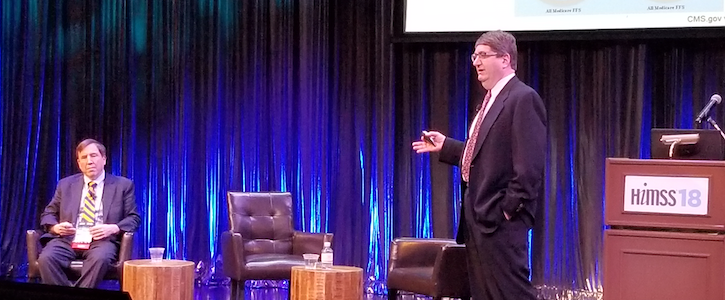Precision Medicine, Sure. But What About Precision Payments?
Cota and Hackensack Meridian Health’s path toward bundled payments holds lessons for others.

It seems more like a bet than a calculated deal. Would your hospital take a flat payment of, say, $100,000 for all care required to treat a breast cancer patient? You might shrug it off or run to your ICD code data, only to realize the insights are flawed and far too broad. Indeed, what makes the proposition so risky is that most organizations don’t know how much they spend per treatment regimen, even if they might think otherwise, said Stuart Goldberg, MD, chief scientific officer of the healthcare analytics start-up Cota.
Last week, Goldberg and his colleague, Andrew Pecora, MD, Cota’s founder and executive chairman, attended HIMSS 2018 in Las Vegas, Nevada, where they detailed the problems that hospital executives might encounter when grappling with the bundled payment question. Then they described the proper way to handle it—a proven path that Cota and New Jersey’s Hackensack Meridian Health (where Goldberg and Pecora also work) have successfully paved and traveled together for 3 types of cancer.
Together, their speeches mapped a way forward for health systems that are ready to advance value-based care in their own walls.
“How do you move from $100,000 for all breast cancer to precision where we start to give the right therapy, the right treatment, and now the right cost and right payment model?” Goldberg asked. “In order to do that, you really need to know who those patients are and what you’re doing and where you can move the margins around.”
Placing the risk on the provider promotes what Cota calls the “Goldilocks Equation,” a simple enough formula on the surface—give the right amount of care to each patient, at the right price—but is difficult to achieve in practice.
Since ICD codes encompass too wide a range of conditions and variables, they are no good for building bundled payments, Goldberg said. Instead, Cota and Hackensack Meridian Health turned to retail barcodes for inspiration in building the Cota Nodal Address system (CNA), a proprietary classification system that accounts for a number of details regarding a patient’s disease and treatment.
The partners then applied the system to 3000 patients in New Jersey, classifying tumor size, growth rate, and many other attributes. This was crucial because, as researchers have repeatedly found, treatment and the cancer itself hinge on where a patient lives, with low-income people more likely to catch it later on. That disparity disqualifies hospitals from using a national or even regional average when crafting a bundled payment model, Goldberg said.
Thanks to the CNA, the Cota team identified the most common types of cancer and corresponding treatments. When they matched up, they formed what Goldberg called a “widget,” or a situation prime for bundled payments, Goldberg said.
Other cancers, however cost anywhere from $20,000 to $80,000 to treat, making them unsuitable for a one-size-fits-all price tag. But the CNA still enabled Cota and Hackensack Meridian with the information to either pass on the bundled payment in a given situation or investigate why different doctors use such different therapies.
Pecora’s job at Hackensack Meridian is essentially to move the 16-hospital, 7000-physician system from the fee-for-service model to value-based care without bankrupting the system. It’s all about reducing variance, in both cost and care, while avoiding “cookbook medicine,” he said. It’s a problem facing the healthcare system at large, which spends trillions of dollars on unnecessary care.
After Cota, IBM Watson, and Hackensack teamed up to take on the challenge for lung, colorectal, and breast cancers, they developed 7 bundles for 2 of the cancers and 11 for the third, Pecora said. They found that costs mostly stay in line, with some variance, which pleased the insurer that piloted the program for several years enough to agree to the bundled system going forward.
Convincing doctors to agree on elements of the bundled payment program was difficult, but the innovators pointed to hard data and emphasized that they would never settle for lesser outcomes. The goal was to change physician behaviors, so that they might pick the route that leads to the best outcomes and costs for patients. “Doctors fought, screamed, and yelled. No exaggeration,” Pecora said, describing their involvement in crafting the bundled payment models.
But it turned out that physicians never used many of the treatment paths that they advocated so fiercely for. That was true among the 3 types of cancer and in academic and community hospitals, Pecora noted. “This is a behavior that is common, and when we blow it up to everything … it’s the same,” he said. “You see why we’re in the position we’re in.”
Ultimately, after several years of refining the system, doctors gained the ability to see the real-world consequences of their choices. The chief financial officer got the power to simulate what might happen if a certain variable moved. All sides of the health system grew capable of understanding best practices, in terms of treatments and payments.
In the future, Cota plans to translate the CNA system to other diseases. Pecora said it’s a good fit, especially, for behavioral health.
The problem is, it took a great deal of time for the partners to develop the system. Right now, under fee for service, health systems don’t need to institute such a tracking system. But that might change one day. And if it does, they will need to decide whether to build their own or follow in the footsteps of trailblazers like Pecora and Goldberg.
Related
How Cota Is Making Oncology More Precise
Aiming for Patient Empowerment, White House Launches MyHealthEData Initiative